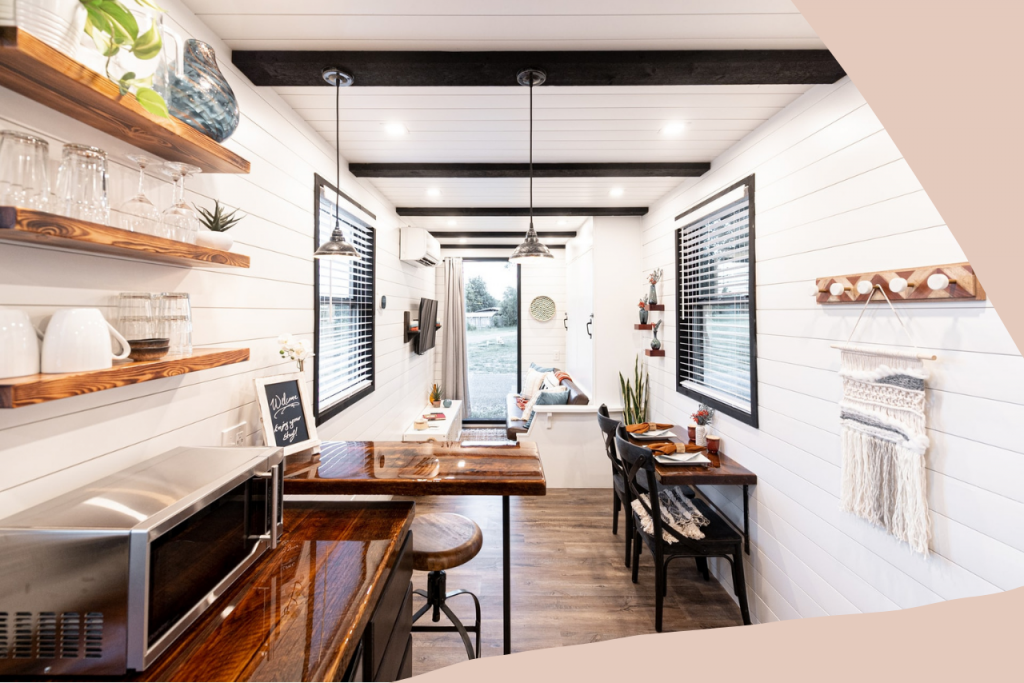The Borrowers, this ain’t. If you haven’t heard of tiny houses and their associated ‘movement’, they are essentially small, affordable structures with a minimal carbon footprint. They can be anywhere from 10 to 40 m² (or, a maximum of 400 sq ft) and their small size is sometimes heralded as a way to simplify one’s life, eliminate clutter and distraction, and get back to the basics.
A romantic notion, sure, but in reality, tiny houses are often little more than portable cabins or sheds, and lack the necessary amenities to be truly liveable. What’s more, the legality of where exactly they can be pitched can sometimes be complicated. If you’re keen to learn more, here are the pros and cons of tiny house living.
THERE ARE FINANCIAL ADVANTAGES
In countries where land is expensive, having a home that takes up less than half a typical residential lot means not paying costly ground rent every month – or even an entire mortgage that could stretch on for decades.
That said, in many countries, there are strict rules governing just where a tiny house can be pitched, with many owners living ‘on the move’ rather than enjoying a stable, stationary position. We’ll discuss that a little more in a moment.
THERE ARE ENVIRONMENTAL BENEFITS
The biggest advantage of a tiny house is environmental. Owning such a property helps us become aware of how much space we truly need, with the energy usage of such a dwelling vastly lower than a regular sized home. It’s largely because of this reason (along with increased property prices) that the tiny house movement has been growing in popularity in recent years.
Indeed, according to the American Institute of Architects, ‘’Tiny homes…typically produce about 2,000 pounds of CO2 emissions each year as compared to the 28,000 pounds produced by an average-sized home.’’
It’s not only their reduced energy usage that might appeal. Tiny houses boast a reduced carbon footprint in other ways, too. Some tiny houses utilise old, recycled building materials and reclaimed wood to reduce costs and waste even further.
What’s more, some also deploy straw bale insulation, solar panels, rainwater collection and recycling systems.
TIP: You can contact a renewable energy installer to see what options are available even if you don’t have a tiny house.

THE CHANCE TO LIVE ON THE MOVE
Whether this is a pro or a con depends somewhat on your disposition. But if you enjoy living on the move, seeing the world and enjoying the freedom of transience, then tiny house living could be you. This is because the legality surrounding where you can put a tiny house is broadly similar to that of a caravan.
Though laws are often changing, you can usually put your tiny house in…
- The garden of your home
- On farmland for 28 days, though you’ll need permission from the farmer, of course
- On a caravan site (because tiny houses are considered ‘movable homes on wheels’, and therefore similar regulations to caravans apply)
- On a glamping site
There are several other discrepancies, loopholes and ambiguities concerning where you can put your tiny house, so it’s worth investigating with your local council whether it’s legal before you purchase one or pitch up anywhere.
THE PROBLEMS WITH TINY HOUSE LIVING
While we could extol all the benefits of a tiny house (less clutter, potential lower carbon footprint, more savings), before you decide to build one, make sure this type of living is right for you.
While the tiny house movement can be a way to avoid mortgage debt and landlord enrichment, bear in mind that tiny houses usually depreciate in value and are hard to sell on. Also, as they are not attached to any land; as such, many owners report a sense of groundlessness, and tiny houses can be constant reminder of a fragile housing state.
Indeed, in Britain, tiny houses have been touted as the answer to Britain’s housing crisis. However as the Architectural Review rightly explains “ Tiny homes are potent signs of our inability to maintain a middle-class standard of living in the face of austerity’’. Stark words, indeed.
Tiny houses shouldn’t be the government’s answer to the housing crisis. Instead, they should be a lifestyle choice, so make sure it’s the right choice for you.
NOT AS EASY TO MOVE
What’s more, whilst some tiny houses are built on trailers to make them mobile, and some have wheels to be moved about more easily, these properties aren’t always as fluid as owners would hope.
The idea of moving from place to place may be a romantic one, but the reality can be different. As Insider points out, “When people move into tiny houses, they don’t realize how difficult it is to travel. For starters, you need to have access to a U-Haul or a bigger truck to attach your home to, which can get costly. You also have to tie down most of your belongings in the home so that they don’t fall and break while moving”.
THE BOTTOM LINE
The appeal of tiny houses is undeniable; a stripped back, decluttered way of life, which is kinder to the environment and easier on the wallet. In some cases, however, the dream doesn’t always match up to reality. That said, if you view a tiny house as a lifestyle choice and a supplement to your normal way of living, you might find this type of property an enjoyable concept.





